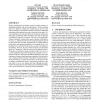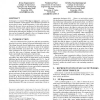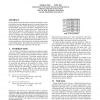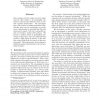IAJIT
2010
14 years 1 months ago
2010
: Privacy is one of the most important properties of an information system must satisfy, in which systems the need to share information among different, not trusted entities, the p...
EDBT
2010
ACM
14 years 1 months ago
2010
ACM
Private matching between datasets owned by distinct parties is a challenging problem with several applications. Private matching allows two parties to identify the records that ar...
CIKM
2010
Springer
14 years 1 months ago
2010
Springer
Online social networks often involve very large numbers of users who share very large volumes of content. This content is increasingly being tagged with geo-spatial and temporal c...
CCS
2010
ACM
14 years 2 months ago
2010
ACM
In this paper, we propose PriMa (Privacy Manager), a privacy protection mechanism which supports semi-automated generation of access rules for users’ profile information. PriMa...
PVLDB
2008
14 years 2 months ago
2008
We identify privacy risks associated with releasing network data sets and provide an algorithm that mitigates those risks. A network consists of entities connected by links repres...
PVLDB
2008
14 years 2 months ago
2008
Given a dataset containing sensitive personal information, a statistical database answers aggregate queries in a manner that preserves individual privacy. We consider the problem ...
VLDB
2002
ACM
14 years 2 months ago
2002
ACM
Data mining services require accurate input data for their results to be meaningful, but privacy concerns may influence users to provide spurious information. We investigate here,...
SIGKDD
2002
14 years 2 months ago
2002
In this paper, we describe the threats to privacy that can occur through data mining and then view the privacy problem as a variation of the inference problem in databases. Keywor...
SIGKDD
2002
14 years 2 months ago
2002
Suppose there are many clients, each having some personal information, and one server, which is interested only in aggregate, statistically significant, properties of this informa...
SIGIR
2002
ACM
14 years 2 months ago
2002
ACM
Collaborative filtering (CF) is valuable in e-commerce, and for direct recommendations for music, movies, news etc. But today's systems have several disadvantages, including ...




